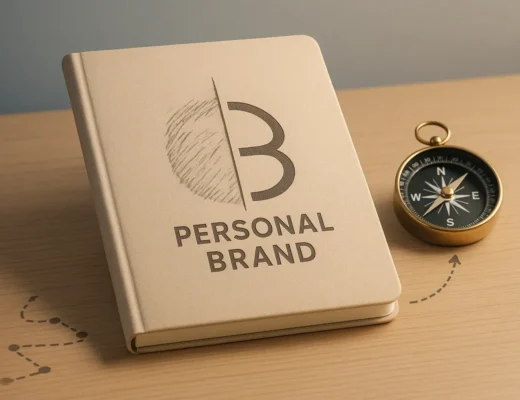Refining your personal brand requires more than just self-reflection. We asked industry experts how they use feedback from others to refine and improve their personal brand. Here are the methods they use to gather constructive criticism. Learn how to align your personal brand with how others perceive you, ensuring authenticity and growth in your career journey.
- Cultivate Open Feedback Culture for Brand Growth
- Treat Feedback as Compass for Brand Alignment
- Implement Quarterly Brand Perception Audits
- Leverage Diverse Feedback Sources for Authenticity
- Create Structured Feedback Loops with Advisors
- Ask Targeted Questions for Actionable Insights
- Analyze Engagement Patterns for Brand Refinement
- Seek Honest Perspectives from Trusted Circles
- Conduct Regular Perception Checks for Alignment
- Use Feedback to Bridge Brand Expectation Gaps
- Transform Criticism into Personal Brand Evolution
- Engage Audience Directly for Brand Insights
- Run Perception Checks to Align Online Presence
- Utilize Feedback Loops for Continuous Improvement
- Implement Brand Perception Audits with Customers
- Treat Feedback as Data for Brand Refinement
- Gather Insights Through Diverse Feedback Methods
How to Refine Your Personal Brand
Cultivate Open Feedback Culture for Brand Growth
Feedback has played a crucial role in shaping and refining my personal brand. I’ve always believed that building a powerful brand isn’t just about showcasing strengths—it’s about actively listening, learning, and evolving through constructive input from others.
One method I consistently use is structured feedback collection from clients. Every month, we conduct feedback sessions where we ask detailed questions about our communication, results, and overall experience. This not only helps us refine our services but also shows how our personal brand is being perceived externally. If a client feels something is missing—even subtly—we take it seriously and improve upon it.
Internally, I encourage my team to give me direct and honest feedback. We’ve cultivated a non-hierarchical, open culture where everyone feels safe to share suggestions, even with me. Some of my most impactful branding changes—like becoming more visible on video content or simplifying my messaging—came from team insights.
Another method I use is tracking audience reactions on social media. Engagement rates, comments, and DMs provide immediate, unfiltered insight into what content is resonating and what’s not. If something consistently underperforms, I analyze it and adjust my tone, format, or message accordingly.
I also rely on peer feedback from industry friends and mentors. Whenever I try something new—whether it’s a reel format, a keynote message, or a website update—I run it by trusted voices who know me well and won’t sugarcoat their thoughts.
For me, feedback isn’t about criticism—it’s a roadmap to growth. By staying open, regularly asking, and acting on what I learn, I’ve been able to align my personal brand more closely with the value I actually deliver. That’s how I keep leveling up—both online and offline.
 Sahil Sachdeva
Sahil Sachdeva
CEO & Founder, Level Up PR
Treat Feedback as Compass for Brand Alignment
What I really think is that feedback is one of the most underrated tools for refining a personal brand. I treat it as a signal, not judgment. The best insights often come from people who do not tell you what you want to hear, but what you need to know.
I use three methods to gather feedback. First, I ask past clients what made them choose me and what almost stopped them. That gives clarity on both strengths and blind spots. Second, I run anonymous surveys through Typeform once a year across my audience to understand how they perceive my content and expertise. Third, I watch for passive feedback—comments, DMs, and what people quote or share back from my content.
Your brand is not what you say; it is what people repeat. Feedback shows you where the message lands and where it falls flat. Use it as your compass, not your scoreboard.
 Sahil Gandhi
Sahil Gandhi
Co-Founder & CMO, Eyda Homes
Implement Quarterly Brand Perception Audits
One of the most valuable things I’ve done to evolve my personal brand was learning how to treat feedback not as criticism, but as calibration.
A few years ago, after giving a keynote, someone I trusted pulled me aside and said, “Your message is strong, but it doesn’t feel like you.” That stuck with me. It wasn’t about the content—it was about tone, posture, and how much of myself I was editing out for the sake of “professionalism.” That moment kicked off a process I still use today.
Every quarter, I reach out to a small mix of people—someone who follows my content, a peer I’ve worked with, and a friend who knows me well—and ask them three questions:
1. What am I projecting clearly?
2. What feels off or misaligned?
3. What could I do more of that feels like me?
I review the responses privately and look for patterns. One quarter, for example, I realized people resonated most with stories I almost didn’t share—the personal ones. That feedback led me to shift how I write and speak, adding more of that honest, unpolished layer. Engagement went up. More importantly, it felt better.
I don’t treat feedback as a mirror. I treat it like a compass—one that helps me ensure my outward presence reflects what matters most internally.
 Murray Seaton
Murray Seaton
Founder and CEO of Hypervibe / Health & Fitness Entrepreneur, Hypervibe (Vibration Plates)
Leverage Diverse Feedback Sources for Authenticity
Using feedback to refine my personal brand has been one of the most underrated but powerful parts of growing my business and my presence in the digital space. I don’t believe in building a brand in a vacuum; it needs to evolve in response to how people actually experience you. For me, feedback is like a mirror. It reflects how well my messaging, tone, and values are landing, or where there’s a disconnect I didn’t see coming.
To gather that kind of input, I’ve built a few feedback loops into my day-to-day. One of the simplest and most effective? I pay close attention to how people respond to my content. If a post, interview, or pitch gets crickets, that’s a signal. If it sparks DMs, shares, or real conversation, I know it’s resonating. I also regularly ask a few trusted peers and clients for their unfiltered take, not just on what I’m saying, but how I’m showing up. Is my message coming across clearly? Does it reflect what it feels like to actually work with me or talk to me? Am I walking the talk?
Beyond that, I make it a point to sit down with my team a couple of times a year for what we call a “brand audit session.” We go through everything—website, social bios, content tone, even email language—and ask, “Is this still us? Is this still me?” Those sessions always surface little blind spots and huge opportunities for alignment.
One thing I’ve learned: asking for feedback only works if you’re willing to actually hear it and act on it. Your personal brand should feel like a living reflection of your growth, not a static tagline. And when you welcome that outside perspective, you’re not losing authenticity; you’re sharpening it.
 Darryl Stevens
Darryl Stevens
CEO, Digitech Web Design
Create Structured Feedback Loops with Advisors
I treat feedback like gold—especially when it’s honest, specific, and comes from people I respect. Over the years, I’ve learned that refining a personal brand isn’t about pleasing everyone; it’s about sharpening the signal so the right people hear it loud and clear.
I gather constructive criticism in a few key ways:
1. Trusted Circles – I regularly check in with a small group of colleagues, collaborators, and fellow creatives who know me well and aren’t afraid to be candid. They’ll tell me if something feels off-brand or if I’m underselling my strengths.
2. Audience Engagement – I pay attention to how people respond to my work—comments, shares, questions, or even what they don’t mention. That silence can be just as telling. If a story, blog post, or video doesn’t resonate, I ask why.
3. Gut Check + Reflection – After receiving feedback, I don’t immediately act. I sit with it. I ask: Is this helping me grow into my truest voice, or pulling me away from it? The best feedback feels like truth I already sensed, reflected back with clarity.
Early in my career, a boss once told me I sounded like “a breathy little girl” when answering the phone. It stung—but I took it to heart. I trained myself to speak with authority, which later opened doors for voiceover work, including narrating some of our earliest videos. That’s the kind of feedback that transformed me—not just professionally, but personally.
So I welcome critique—but I filter it through intuition. Because the goal isn’t to polish myself into something generic. It’s to become more authentically me—refined, resonant, and real.
 Patty Mooney
Patty Mooney
Producer, Editor, Content Creator, San Diego Video Production
Ask Targeted Questions for Actionable Insights
Feedback is one of the most powerful tools I use to evolve my personal brand. I treat it like data—emotional honesty layered with strategic insight. I regularly ask trusted clients, collaborators, and peers how they perceive my brand—what stands out, what feels unclear, and what they think I could do better.
I also closely examine engagement patterns: what content people save, share, or comment on. That kind of passive feedback is just as important as direct input. I use surveys, informal voice notes, and even DM conversations to gather insight. Most importantly, I act on what resonates. Personal branding isn’t static—it’s iterative. The goal isn’t to be perfect; it’s to be aligned and clear in every touchpoint.
 Kristin Marquet
Kristin Marquet
Founder & Creative Director, Marquet Media
Analyze Engagement Patterns for Brand Refinement
Refining a personal brand requires self-awareness, but more importantly, it requires intentional feedback loops, especially from people who see you in different contexts. For me, that process starts by seeking feedback not just when things go wrong, but proactively and regularly, particularly from colleagues, mentors, and even clients who understand both my work and my values.
I’ve found it incredibly useful to ask, “How did that message land?” or “Did that feel like me?” after public speaking engagements, team presentations, or high-stakes client calls. The goal isn’t just to assess performance; it’s to understand how my communication style and personal narrative are being received.
To gather meaningful feedback, I use a mix of direct conversations, anonymous surveys, and subtle cues, like how people describe me when introducing me to others. That last one is particularly revealing. If what they say aligns with how I want to be perceived—strategic, thoughtful, clear—it reinforces that my personal brand is coming through authentically. If not, I take that as a cue to re-evaluate how I’m showing up or communicating.
The key to using feedback effectively is to treat it like data, not judgment. You’re not trying to please everyone; you’re trying to refine how well your outward presence reflects your internal principles. When you do that consistently, your personal brand becomes less about image and more about alignment, and that’s when it really starts to resonate.
 Joel Butterly
Joel Butterly
CEO, InGenius Prep
Seek Honest Perspectives from Trusted Circles
Creating structured feedback loops with diverse perspectives has proven more valuable for refining our personal brand than relying on spontaneous comments or social media metrics.
When repositioning my brand approach last year, I assembled a small “personal board of advisors” with a client, a team member, an industry peer, and someone outside my field. I sent each person identical questions about how they perceived my expertise, communication style, and unique value. Their structured feedback revealed a significant gap—while I emphasized my technical marketing knowledge, others valued my storytelling approach to complex topics far more. This insight completely reshaped my content strategy to highlight this strength I hadn’t fully recognized.
Many personal branding discussions focus on quantitative metrics like engagement rates or follower counts. However, my experience shows that qualitative feedback from targeted sources provides more actionable insights for meaningful brand improvements.
I’ve found that creating specific feedback mechanisms works better than general requests for input. Rather than asking, “What do you think about my content?” I now ask pointed questions like, “What specific point from my recent article did you find most valuable?” or “Where did you find yourself disagreeing with my perspective?” These targeted questions generate more useful responses.
For professionals looking to implement better feedback systems, start by identifying 3-5 individuals whose perspectives represent different audiences important to your brand. Create a quarterly check-in process with specific questions that probe beyond surface impressions to uncover how your content actually resonates.
The most impactful personal brands evolve through deliberate refinement based on structured feedback rather than reaction to random input. Creating intentional feedback loops with diverse perspectives ensures your brand grows in directions that authentically connect with your most important audiences.
 Matt Bowman
Matt Bowman
Founder, Thrive Local
Conduct Regular Perception Checks for Alignment
I believe feedback is one of the most underrated assets in building a personal brand that truly connects. I treat it as a performance audit rather than a personal judgment. One way I consistently gather useful feedback is by asking past clients and collaborators two specific questions after a project concludes:
1. What made you trust me?
2. What almost made you say no?
These answers reveal how your brand is perceived at key decision points. I also conduct a short quarterly feedback survey through Typeform where people in my network rate the clarity, consistency, and relevance of my content.
If you rely solely on analytics, you will miss the emotional signals behind why people follow, trust, or buy. Real feedback tells you where the brand resonates and where it confuses. The method is not as important as your willingness to listen without becoming defensive. That is where real growth occurs.
 Sahil Gandhi
Sahil Gandhi
Co-Founder & CMO, Eyda Homes
Use Feedback to Bridge Brand Expectation Gaps
Feedback has been one of the most helpful parts of shaping my personal brand. Sometimes it comes through direct conversations, other times from how people respond to what I share. I try to listen closely to what feels clear to them and what feels confusing. One method that works well is simply asking people I trust how they would describe me based on what they see online. Their answers often highlight blind spots or strengths I didn’t realize were coming through. It helps keep the brand grounded and honest.
 Bhavik Sarkhedi
Bhavik Sarkhedi
Founder & Content Lead, Ohh My Brand
Transform Criticism into Personal Brand Evolution
Feedback from others is invaluable in shaping and strengthening my personal brand. It offers perspectives I might not see myself and helps identify areas for growth and refinement. I actively seek constructive criticism through various methods to ensure a well-rounded understanding of how my brand is perceived.
One key approach is engaging directly with my audience on social media and other platforms. I pay close attention to comments, questions, and direct messages, looking for patterns or recurring themes in the feedback I receive. What resonates? What confuses? Where could I be clearer or more impactful? I also solicit more formal feedback by occasionally asking specific questions related to my content or messaging.
Additionally, I value the insights of trusted peers and mentors who can offer a more objective viewpoint. Sharing my work with them and asking for candid critiques provides valuable perspectives from individuals who understand the broader landscape. By synthesizing feedback from various sources, I can identify areas where adjustments might be needed to ensure my personal brand is authentic, impactful, and continuously evolving in a positive direction.
 Michael Gargiulo
Michael Gargiulo
Founder, CEO, VPN.com
Engage Audience Directly for Brand Insights
Feedback is my compass—it tells me what’s resonating and what’s just noise. When it comes to refining my personal brand, I treat it like product development: listen, test, iterate.
I gather feedback in three ways:
1. Direct asks — I periodically reach out to peers, mentors, and even past collaborators with a simple question: “When you think of me, what comes to mind first?” The answers are often surprisingly honest—and revealing.
2. Content performance — I look at which posts, interviews, or comments spark replies, shares, or conversations. Engagement is feedback.
3. Quiet signals — Who reaches out after a post? What kind of opportunities show up? That tells me how my brand is perceived beyond what people say.
Don’t ask, “What did you think?” Ask, “What stuck with you?” That’s where your brand lives.
 Yulii Cherevko
Yulii Cherevko
CEO & Co-Owner, Paintit.ai
Run Perception Checks to Align Online Presence
One of the most underrated drivers of my growth is feedback. For example, at the outset of my career, I launched a website that failed miserably. It wasn’t because the idea was bad; it was because I didn’t bother to ask anyone what they actually thought until it was too late.
Since that disappointment, I always ensure I have feedback loops built into my projects. I send a casual DM after a campaign launch, hop on a client wrap-up call, or even just observe how people respond to the content online.
More often than not, the people with the finest and rarest insights aren’t the ones who are trying to flatter you. They genuinely want you to succeed. Keeping that perspective has been incredibly valuable to me, and I’ve learned not to take criticism personally.
 Spencergarret Fernandez
Spencergarret Fernandez
SEO and Smo Specialist, Web Development, Founder & CEO, SEO Echelon
Utilize Feedback Loops for Continuous Improvement
One method that has helped me continuously improve my personal brand is running regular “Perception Checks”—simple but powerful feedback loops that reveal how others actually experience your online presence.
Every few months, I ask a handful of trusted peers, collaborators, and even a few followers three specific questions:
- What’s one word you associate with my brand?
- Where do you think I’m underplaying or overplaying my strengths?
- Based only on what you see online, what would you think I do best?
This kind of focused feedback shows me where there’s a gap between what I think I’m communicating and what’s actually coming through. I then compare their answers to things like my social media bios, recent content, and how I show up in conversations. If there’s a mismatch, I update my messaging. If there’s overlap, I double down on what’s working.
It’s a lightweight but high-impact way to stay aligned with how others perceive your brand—and make sure your voice, values, and strengths are showing up clearly.
 Ahmed Yousuf
Ahmed Yousuf
Financial Author & SEO Expert Manager, CoinTime
Implement Brand Perception Audits with Customers
I view feedback as one of the most powerful tools for refining my personal brand. Consistent, constructive feedback helps me stay grounded and ensures that the image I project aligns with the values and message I want to convey. Over time, I’ve learned to actively seek feedback not only from my team and customers but also from peers in the industry and business mentors who have a different perspective.
One method I use to gather constructive criticism is through regular, open-ended conversations with my team. I ask for honest input on everything from how I communicate to how I present myself in business settings. I also encourage feedback after projects or client interactions, asking, “What went well?” and “What could I have done better?” This creates a culture of openness and trust, and it helps me continually improve how I show up in my business.
Another key method is paying attention to client feedback and reviews. Clients are often the most honest about what they perceive and experience, and their insights help me understand how my business and personal interactions are perceived. I pay close attention to what clients appreciate and, equally, where they feel we could improve.
Networking events and industry groups are great places to get feedback from colleagues and competitors. These informal settings allow for candid conversations that often lead to valuable insights on areas where I can refine my personal brand.
I also make use of self-reflection, reviewing the feedback I receive and comparing it to my own perceptions of my actions. This helps me determine whether there are areas where I may be blind to the way I’m coming across and whether there’s room for more authenticity or clarity.
My approach is about being open to change and using feedback as a way to stay connected to my audience, improve my approach, and ensure that my personal brand evolves alongside my business.
 Carl Dugan
Carl Dugan
CEO, Viking Roofing
Treat Feedback as Data for Brand Refinement
Implementing structured “brand perception audits” with customers who have completed their moving journeys provides the most valuable feedback for refining our approach.
I’ve found that standard satisfaction surveys rarely capture the nuanced impressions that shape personal and company brand perception.
These deep-dive conversations focus on the gap between expectations and experience at each touchpoint in the moving process.
Rather than asking general questions about satisfaction, we explore specific moments–like initial quote requests, coordination communications, and follow-up interactions–to understand how our brand promises align with customer perceptions.
This approach has revealed subtle disconnects we would never have identified through standard metrics.
The most effective method for gathering genuinely constructive criticism has been creating psychological safety through our ‘insight partner’ program.
We invite selected customers who’ve had both positive and challenging experiences to participate in quarterly feedback sessions with leadership, compensating them for their time and expertise.
By establishing recurring relationships with these customers and demonstrating how their previous feedback led to specific improvements, we’ve created an environment where people feel comfortable sharing authentic observations rather than just polite comments.
This has resulted in actionable insights that have significantly improved both our personal leadership approaches and overall brand strategy.
 Vidyadhar Garapati
Vidyadhar Garapati
CEO, Movers.com
Gather Insights Through Diverse Feedback Methods
“I’ll listen as long as it doesn’t hurt” is what most people actually mean when they say they’re open to feedback. The reality is that growth doesn’t come from comfort. I’ve learned to treat feedback as data, not as a verdict on who I am, but as insight into how I present myself.
Through quick check-ins with colleagues, post-project reflections, and spotting trends in casual remarks, I make a point of consistently seeking feedback in low-key, regular ways. The most valuable input often isn’t labeled as “constructive criticism”—it’s buried in someone’s hesitation, a raised eyebrow, or a “Hey, have you thought about…?” I jot that down. I review it. And then I ask myself: Is this a blind spot or a misalignment?
By fine-tuning the signal I’m putting out and picking up on what’s not being said, that’s how I shape and sharpen my personal brand.
 Colin Potts
Colin Potts
Chief Operating Officer, Regenerative Orthopedics & Sports Medicine







